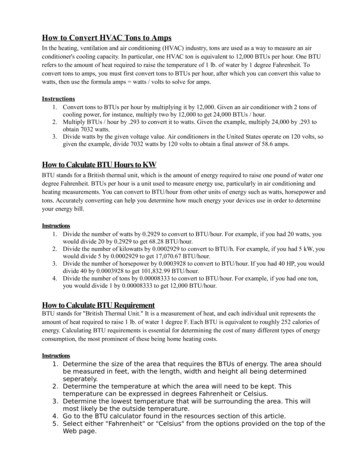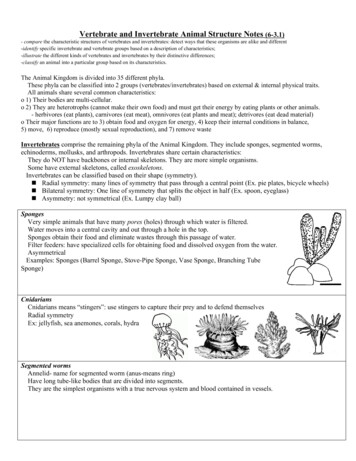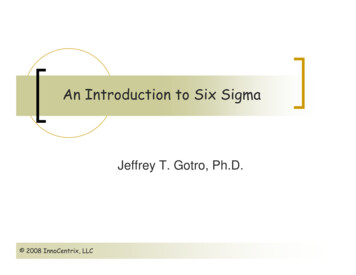
Transcription
Divide and ConquerStrategy for ProblemSolving - RecursiveFunctionsAtul PrakashReferences:1. Ch. 4, Downey.2. Introduction to Recursion Online Notes Ch. 70 by B. Kjell : http://chortle.ccsu.edu/java5/Notes/chap70/ch70 1.html3.
Divide and Conquer Basic Idea of Divide and Conquer: If the problem is easy, solve it directly If the problem cannot be solved as is,decompose it into smaller parts,. Solvethe smaller parts
Some Examples Finding the exit from within a hotel Finding your car in a parking lot Looking up a name in a phone book
Mental Exercise You are at the end of a very long hotellobby with a long series of doors, with onedoor next to you.You are looking for thedoor that leads to the fire exit. What is your first step?
First Step
What do you do if thefirst step does notwork?
FindExit Strategy Try the door next to you for the exit If it does not lead to an exit, advance to thenext door. And repeat the FindExit strategy
Elements of theSolution Try a direct solution: check the nearbydoor for the exit If it does not work, use the same strategyon the smaller problem after advancing tothe next door
Recursion in Words ofWisdom Philosopher Lao-tzu: The journey of a thousand miles beginswith a single step
Breaking a Stone intoDust BreakStone:You want to ground a stoneinto dust (very small stones) What is your first step?
First Step Use a hammer and strike the stone
Next Step If a stone pieces that result is smallenough, we are done with that part For pieces that are too large, repeat theBreakStone process
Common Elements If the problem is small enough to be solveddirectly, do it If not, find a smaller problem and use itssolution to create the solution to the largerproblem
Looking up a PhoneNumber You have a phone book with names inalphabetical order Given a name, what is your first step?
First Step Open the phone book in the middle (or ona random page) If name within the range of names on thatpage, find it, and we are done
Smaller Problem Step If name not in the page, you can excludeeither the left part or the right part Search in the remaining partexcluded
After another stepexcludedexcluded
Other Problems Recursively-defined functions Factorial: n! Fibonacci numbers Ackermann Function Tower of Hanoi Fractals Tree and data searches
Glue in Divide andConquer Often, the parts must be “glued”into asolutionPartition 1LargeproblemDecomposePartition 2Partition 3Partition 4GlueSolution
Factorial Problem Example: Findingfactorial of n 1 n! n(n-1)(n-2) 1Divide and ConquerStrategy:factorial(n)Solve simplerproblem if n 1n*factorial(n-1) if n 1: n! 1(direct solution),else: n! n *(n-1)!factorial(1) 1
Divide and Conquernfactorial(n)factorial(n-1)*Gluen!
Recursion in Functions When a function makesuse of itself, as in adivide-and-conquerstrategy, it is calledrecursionRecursion requires: Base case or directsolution step. (e.g.,factorial(1)) Recursive step(s): A function callingitself on a smallerproblem. E.g.,n*factorial(n-1)Eventually, allrecursive steps mustreduce to the basecase
Java Code Definition: n! is defined as 1 ifn 0 (direct solution),Otherwise, n! n * (n-1)! (divide-and-conquer)Direct solutionfor base caseDivide andConquerfor largercasepublic static int factorial(int n) {if (n 0) return 1;else return n * factorial(n-1);// post-condition: returns n!}
StackDiagram6factorial(3)(local n is 3)2factorial(n 2)(local n is 2)1factorial(1)(local n is 1)1factorial(0)(local n is 0)
to base case?UnderstandingRecursive Programs Why does it work?public static int factorial(int n) {if (n 0) return 1;else return n * factorial(n-1);// post-condition: returns n!}Proof by induction:(1) Solution works for n 0(2) If it works for n-1, it works for n(3) 1. and 2. imply, it works for n 1(4) 2. and 3. imply it works for n 2 and in fact anylarger n
Handling Errors What if n is 1 in the factorial program? factorial(-1) will call factorial (-2), which will callfactorial(-3), etc. Recursion will never reach the base case Document pre-conditions and post-conditionsUse assert orerror checksto indicatesomething thatis assumed orexpected tobe Truepublic static int factorial(int n) {assert(n 0); // pre-conditionif (n 0) return 1;else return n * factorial(n-1);// post-condition: returns n!}
Tower of Hanoi Initial state: n disks indecreasing order of sizeon one peg Goal: move all the disksto the 2nd peg. Move one disk at a time Constraint: a disk cannever be on top of asmaller diskSource: wikipedia. Copied under Wikimedia Common LIcense
Divide-and-ConquerStrategy If n is 1, the solution is trivial. Just move thedisk to the desired peg For n 1, let's assume we know how tosolve the problem for n-1 disks. Can we use that to construct a solution forn disks?
Solution Strategy Base case: if n is 1, thesolution is trivial. Justmove the disk Move the left-overdisk from page A topeg B Otherwise: Move (n-1) disks frompeg C to peg B usingHanoi for (n-1) disks Move (n-1) disks frompeg A to peg C usingHanoi for n-1 disksABC
Java Codepublic static void move(Object pegA, Object pegB) {System.out.println( "move disk from " pegA " to " pegB);}public static void hanoi(int n, Object pegA, Object pegB, Object pegC) {//precondition: n 1. disks are on pegAassert(n 1);if (n 1) {move(pegA, pegB);} else {hanoi(n-1, pegA, pegC, pegB);move(pegA, pegB);hanoi(n-1, pegC, pegB, pegA);}// post-condition: top n disks moved from pegA to pegB}hanoi(3, "peg 1", "peg 2", "peg 3");extShow a run in Eclipse
Tower of HanoiAnalysisTower of Hanoi is pretty slow for larger values of n.Q: How many disk moves (approximately) for a given n?Note: The above is on Python version. Java is analogous
OPTIONALPerformance!"# %&"'&()*" ,&! - &./,&*&Tower of Hanoireally slows down forlarge n&!!"%#!"%!!" #!" !!"#!"!"'" (" )" *" "%!"% "%%"!"# %&'"()* ,-)./0)12)(# "("!#'"!#&")* ,-./*0"!#%"!# "!"!" !"%!"&!"'!"(!!"( !"%&"Factorial's time is roughlylinear with n.We say that the time forfactorial is O(n), called BigOh(n), or linear in n
Big-Oh A way to measure how execution time ormemory use will grow with input size Formally, f(n) is O(g(n)) iff for sufficientlylarge values of n, f(n) is within constanttimes of g(n). That is, f(n) c.g(n) for all n N and someconstant c.
Big-Oh examples 3n 2 is O(n) because 3n 1 4n for largen 1000n 100000 is also O(n) 10n 3 is O(n ) 2 n is O(2 )2n23n
Basic Points Ignore the small stuff n 10: ignore the 10 n n: ignore the n Simplify Replace 10 by 1. Both are O(1) 2n can be replaced by n. Both are O(n)2
Factorial Time Analysis Factorial of 0: constant time. T(0) 1(treat constants as 1)Time required to compute factorial of n: T(n) T(n-1) 1(treat constants as 1)T(4) T(3) 1 T(2) 1 1 T(1) 1 1 1 T(0) 1 1 1 1 5In general, T(n) is n 1 or O(n)
Hanoi: Number ofMovesLet T(n) number of diskmoves for n disksT(1) 1T(2) 2*T(1) 1 3T(3) 2*T(2) 1 7T(4) 2*T(3) 1 15See a pattern? T(n) 2n - 1 or O(2n ) This is an example of anexponential-timeprogram.Hanoi for 64 disks wouldtake a very, very longtime!
Advantage of Big-OhAnalysis Big-Oh gives you trends versus problemsize Big-Oh analysis holds even if computersbecome 10 times faster
Common GrowthRates O(1): constant time. For example, arraylookup, given an index O(n): linear time. For example, scan an arrayof length n for a value O(log n): Between constant and linear time. O(2 ): Exponential time.Very badnWe will see lots of examples later
Fractals Fractals are recursivedrawings. They occur alot in nature and there isa field called fractalgeometry. Can userecursion to draw themBut, how to do drawings in Java?
Drawing in Java Java has several graphics packages: awt, swing, etc. We will use ACM Graphics package for Java, as itis designed for educational use Download acm.jar and*.java from CTools in 11lecture-code folder Documentation: http://jtf.acm.org/tutorial/Introduction.html
Using acm.jarCommand line (use semi-colons on Windows):javac -cp .:/path/to/acm.jar *.javajava -cp .:/path/to/acm.jar MainClass In Eclipse, go toProject - Properties - Java Build Path Add acm.jar tothe build path
ACM Graphics Package Create shapes, e.g., GLabel, GLine, GTurtle,etc. in a GraphicsProgram Add them to the canvas using the add()routine getWidth() and getHeight() return theheight of a canvas. Coordinate system: Top-left corner is (0,0).
Mini-exercise Compile and run one of the Helloprograms that use the ACM jar file. Submita screen snapshot Generate the stack of squares and submit ascreen snapshot
Turtle Programming:Drawing a Squarepublic static void drawSquare(GTurtle t, double len) {t.penDown();for (int i 0; i 4; i ) {t.forward(len);t.left(90);}}public void run() {// Place turtle in the center of the canvasGTurtle turtle new GTurtle(getWidth()/2.0, getHeight()/2.0);add(turtle);drawSquare(turtle, 100.0);}
Hello World Programpublic class HelloGraphics extends GraphicsProgram {public void run() {GLabel label new GLabel("hello, world");label.setFont("SansSerif-100");double x (getWidth() - label.getWidth()) / 2;double y (getHeight() label.getAscent()) / 2;add(label, x, y);}/* Standard Java entry point. Call MainClass.start(args)to get graphics program going */public static void main(String[] args) {new HelloGraphics().start(args);}}
Stack of Squares usingRecursionpublic void drawStack(GTurtle t, double len, int squarecount) {// precondition: turtle at "origin"if (squarecount 0) return;drawSquare(t, len);// draw big square, ending at the start location.t.left(90); t.forward(len); t.right(90); // go to the top-leftdrawStack(t, len/2.0, squarecount-1);t.right(90); t.forward(len); t.left(90); // return to origin// post-condition: draw the stack and return to origin}public void run() {GTurtle turtle new GTurtle(getWidth()/2.0, getHeight()/2.0);add(turtle);drawStack(turtle, 100.0, 3);}
Another Way Use shape drawing functions rather thanturtles. Basic primitive draw a shape of a given size at (x, y) Shapes include lines, squares, circles,rectangles, etc. Shapes can have attributes, such as linethickness, color, fill, etc.
Drawing a square// File: SquareStackWithShapes.java// draws a square at (x, y) of length len. Origin top-left corner.public void drawSquare(double x, double y, double len) {GRect r new GRect(x, y, len, len);add(r);}public void run() {drawSquare(getWidth()/2, getHeight()/2, 100.0);}
Drawing a Stack// draw a stack squarecount deep at (x, y), with squares becoming// half the size as you go up the stack.public void drawStack(double x, double y, double len, int squarecount) {if (squarecount 0) return;drawSquare(x, y, len);// draw big square, ending at the start location.drawStack(x, y-len/2.0, len/2.0, squarecount-1);}Draw the big square. Note: origin top-left corner.Draw the remaining stack with origin 1/2 length up.
public void drawTreeOfSquares(double x, double y, double len, int squarecount) {if (squarecount 0) return;drawSquare(x, y, len);drawTreeOfSquares(x-len*0.25, y-len*0.5, len*0.5, squarecount-1);drawTreeOfSquares(x len*0.75, y-len*0.5, len*0.5, squarecount-1);}
Hierarchical Data (trees)MichaelJohnAnnMaryBobHarryExample: child-dad/mom relationshipCarol
Count nodes in a TreeIf tree empty, return 0Else, returnone count of left subtree count of right subtree
Summary Divide and Conquer is a common problemsolving strategy It often maps to recursive algorithms Big-Oh notation a way to estimate howtime required to solve a problem will growas the problem size increases
Divide and Conquer Basic Idea of Divide and Conquer: If the problem is easy, solve it directly If the problem cannot be solved as is, decompose it into smaller parts,. Solve the smaller parts










